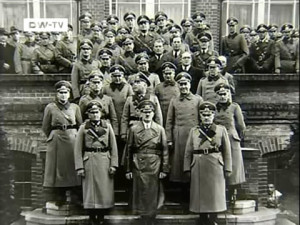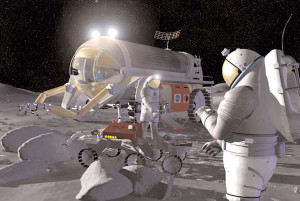Operation Paperclip built on the results of Nazi research on captive human subjects. Researchers hoping to develop a truth serum at the Edgewood Arsenal, in Maryland, worked with Operation Paperclip personnel to test psychoactive drugs on almost 7,000 unwitting American soldiers between 1955 and 1975.
“Those experiments, and Paperclip itself, were among the first manifestations of what became a guiding principle of the Cold War, that the ends sometimes justified the means” wrote Christine Gibson, a former editor at American Heritage magazine.
“I have always been outraged at the adoration our country has given this Nazi von Braun,” says the Reverend John Southwick of Simi Valley, California. “I grew up in the London Blitz in WWII. Those Nazis took away my childhood.”
“I lived three miles from the de Havilland Aircraft Company aircraft factory where they built engines for fighters,” says Southwick who grew up in Edgeware, a pleasant suburb ten miles outside of central London with a large Jewish population. “The plant was well camouflaged, but the Nazis tried to bomb it from 1939 to 1945. They never hit it but the houses all around it were hit. My house was hit twice, not a direct hit but lots of damage.”
Southwick now lives next to the former Rocketdyne lab where von Braun’s German test stands were recreated. “Getting us to the moon was a great feat, but nothing can wipe away the shame of being responsible for thousands of deaths. Von Braun never owned up to his role in World War II,” Southwick says.
“The Good Reverend John” Southwick is a member of a community activist group called the Radiation Rangers who have such monikers as “Toxic Terry” and “Perchlorate Patty.”
The group has fought development of land next to the lab in Runkle Canyon because of radiation and heavy metal contamination concerns. Since 2006, the Rangers have battled mega-developer KB Home over a proposed 461 home development in the canyon which has tested high in radioactive strontium-90 and heavy metals including arsenic, chromium and vanadium.
“Americans have always loved our space program and I’m no exception,” says Southwick. “But this collective amnesia about who von Braun really was speaks to a larger moral failing. The ‘anything goes’ mantra practiced by the aerospace industry and NASA itself, has polluted Rocketdyne with incredible amounts of contamination. The moral failing today is the lab owner, Boeing, and NASA doing everything they can to get out of that place before properly cleaning it up.”
Regardless, von Braun’s controversial past has not persuaded many aerospace workers that his contribution to American rocketry was nothing short of legendary. Robert S. Kraemer is one of them. Kraemer is the author of Rocketdyne: Powering Humans into Space (American Institute of Aeronautics and Astronautics, 2006), and served as head of Advanced Design at Rocketdyne and later as NASA’s Director of Planetary Exploration.
“It is noteworthy that von Braun’s progression of missions, from a reusable space shuttle to a space station to landing humans on Mars, is the plan that NASA adopted almost from its beginning, even though it would not appear as a formal written and approved plan for NASA until January 2004,” wrote Kraemer. “The vehicles have been scaled down a bit from von Braun’s conceptual designs, and a schedule for the Mars mission is still not set, but the plan is intact and as sound as ever.”
Soundly expensive. The International Space Station (ISS) is the most high-priced object ever constructed with cost estimates ranging from $35 billion to $160 billion. The ISS has been routinely criticized for its exorbitant expense and failed experiments, especially after the cancellation of the ambitious Centrifuge Accommodations Module. The cherished goal of mastering fusion on ISS has never materialized and most of the experiments requiring weightlessness could be done far cheaper in so-called “vomit comets” which are aircraft that can briefly provide a nearly weightless environment.
Ironically, the space station is already testing the effects of cosmic radiation on ISS astronauts wearing special ionization detection helmets that would appear to obviate the need to nuke the monkeys.
The Italian experiment began last summer and is described on the NASA website:
“Anomalous Long Term Effects in Astronauts’ Central Nervous System (ALTEA) integrates several diagnostic technologies to measure the effect of the exposure of crewmembers to cosmic radiation. It will improve the understanding of the impacts that radiation has on the human central nervous system functions, and will study the flashes from cosmic radiation that astronauts have reported since the Apollo flights.”












Before we begin colonizing other planets, we should probably first learn to peacefully coexist with the animals on this planet rather than treating them as resources that we are free to exploit.
Readers can contact NASA Administrator Charles Bolden via PETA’s online Action Alert: http://www.peta.org/nasa
I grew up in the 1960s and we were the dead center target of a generation raised to expect and adore space exploration. It was supposed to prove that we were better than everyone else. Such a sad commentary on what has become the ultimately corrupt core of that concept that its legacy has been reduced to a plan to torture a small group of little monkeys. As Michael points out, we already know what happens when a living creature is nuked with radiation. It is not good. So what is the point? Aside from satiating someone’s sadism or someone’s incomprehensible indifference to suffering, it must ultimately be about a lot of money. A lot. It is always the money.